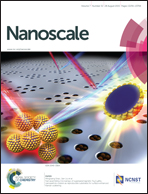A tunable sub-100 nm silicon nanopore array with an AAO membrane mask: reducing unwanted surface etching by introducing a PMMA interlayer†
Abstract
Highly ordered silicon (Si) nanopores with a tunable sub-100 nm diameter were fabricated by a CF4 plasma etching process using an anodic aluminum oxide (AAO) membrane as an etching mask. To enhance the conformal contact of the AAO membrane mask to the underlying Si substrate, poly(methyl methacrylate) (PMMA) was spin-coated on top of the Si substrate prior to the transfer of the AAO membrane. The AAO membrane mask was fabricated by two-step anodization and subsequent removal of the aluminum support and the barrier layer, which was then transferred to the PMMA-coated Si substrate. Contact printing was performed on the sample with a pressure of 50 psi and a temperature of 120 °C to make a conformal contact of the AAO membrane mask to the Si substrate. The CF4 plasma etching was conducted to transfer nanopores onto the Si substrate through the PMMA interlayer. The introduced PMMA interlayer prevented unwanted surface etching of the Si substrate by eliminating the etching ions and radicals bouncing at the gap between the mask and the substrate, resulting in a smooth Si nanopore array.


 Please wait while we load your content...
Please wait while we load your content...